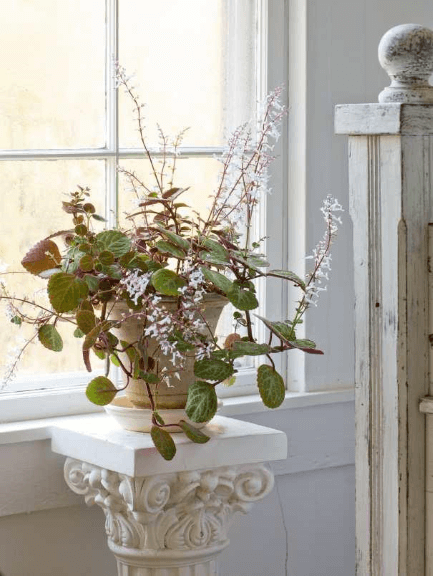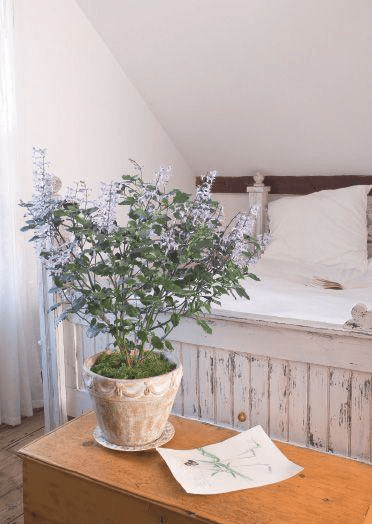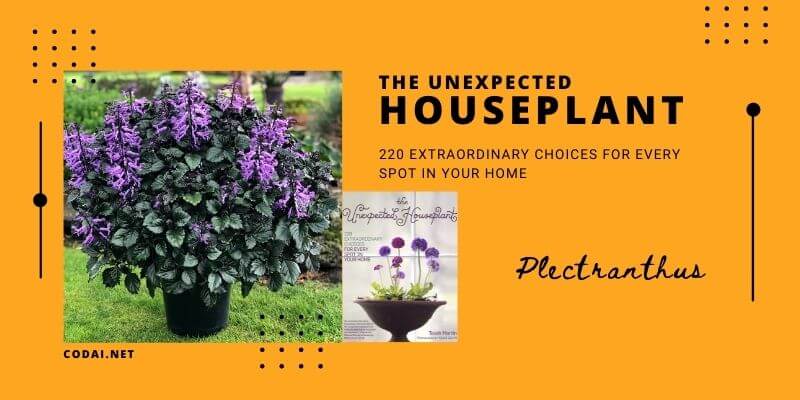[Ebook Việt hóa] The Unexpected Houseplant: 220 Extraordinary Choices for Every Spot in Your Home, Chi Plectranthus
[Ebook Việt Hoá] The Unexpected Houseplant: Plectranthus
- Nguồn: [Ebook] The Unexpected Houseplant: 220 Extraordinary Choices for Every Spot in Your Home –
- Biên tập: Dũng Cá Xinh (Tháng 02/2022)
- Dịch: Vui Nguyễn
English
PLECTRANTHUS
AUTUMN HAS ITS perks. Take plectranthus, for example. I’ve always had an affinity for plectranthus. Although some people might simply see plectranthus as texturally tricked-out close cousins to coleus (solenostemon), I’ve always stood in awe of their finery (if you discount Swedish ivy, Plectranthus verticillatus, which is devoid of any redeeming qualities whatsoever). Otherwise, these plants have great foliage, are easy to cultivate, and burst into flower in autumn when most bloomers are winding down. Compared to other houseplants with fewer virtues, plectranthus are quite a promising package.

I was going to say that the curtain rises for plectranthus in autumn, but I stopped myself short. After all, most plectranthus do a valiant job of entertaining throughout the year. Plectranthus amboinicus is a case in point. We’re talking 2- to 3-inch (5–8cm) wide, rounded leaves covered in soft, strokeable velveteen. Each leaf is thick, like a succulent (which might account for the plant’s ability to endure long periods without water) and the pea-green color of the species is pleasant enough to look upon, but all sorts of gold, cream, and darker green variegated cultivars exist to add intrigue. As it turns out, the flowers are nothing to applaud and are best removed, but other Plectranthus species put more emphasis in their blossoms, which often gear up when the days begin to shorten.
A stellar example is Plectranthus oertendahlii. Where would I be without this plant? I tuck it in the base of potted trees, I use it as “socks and shoes” (I believe Brent and Becky Heath of Brent and Becky’s Bulbs in Gloucester, Virginia, coined that phrase) beneath all sorts of plants that are all stem and lack interest down below. Unlike Plectranthus amboinicus, which grows upright, Plectranthus oertendahlii swoops down on graceful arching stems. Although there is some diversity in this species from nursery to nursery, I opt for versions that have silver-marked veins on each forest-green leaf and deep-burgundy undersides. After the initial investment, no need to spend again. I break off a stem and propagate my own for more of a good thing. As if all that wasn’t enough, Plectranthus oertendahlii adds long sprays of little off-white, guppy-like blossoms in the fall. It sort of puts autumn on the map.

Even more impressive is Plectranthus hilliardiae, a handsome plant throughout the year with plush, deep-green, serrated-edged leaves accented by dark purple undersides. With only minimal pinching, you can achieve a chubby silhouette (and the ability to form a nicely rounded specimen without a whole lot of effort is a trait of this genus). In Plectranthus hilliardiae’s case, you wouldn’t want to pinch past midsummer, because you’d curtail flower production—and that’s really what Plectranthus hilliardiae throws its strength into. Long, bluish-purple, oboe-shaped blossoms with speckles in the throat begin to develop as the days shorten. However, Kirstenbosch National Botanical Garden in South Africa did some complex hybridizing on this species and achieved a cultivar called ‘Mona Lavender’ that blooms through summer and spends its days smothered in flower spires.
There are other species around, and most are worth enlisting into your indoor arena. Whether you’re adopting the velvety silver-leaved Plectranthus argentatus or the wonderfully pungent-smelling Vick’s plant, you can’t really go wrong. Unfortunately, the nomenclature is a disaster for this genus, but what’s in a name? Go with whatever package you find attractive. Most plectranthus grow rapidly, are trouble free, tolerate low light and drought, and look stunning. There is one sticky wicket in the group, and it is Plectranthus thyrsoideus. It is crowned by ravishing spires of sailor-blue blossoms in the dead of winter, making it infinitely tempting. However, it is a stinker to grow (and speaking of smell, the foliage is also unpleasantly scented—moldy comes to mind). Without bright light (of the intensity you are not likely to secure in winter), this plant melts into a fungus-riddled mush. Plus, whiteflies are attracted like magnets. Most other members of the genus are just the opposite. Sure, they might be slightly more compact with bright light, but they don’t demand it. And all make stellar, low-maintenance container foliage plants when summer rolls around.
- ALSO CALLED: Mexican mint, Spanish thyme
| FLOWERS | Tubular white or bluish blossoms in spires |
| FOLIAGE | Often felted, usually handsome |
| OTHER ATTRIBUTES |
Often used in summer containers |
| SIZE | 12–30 inches (30–76cm) in height, depending on species |
| EXPOSURE | East, west, or south |
| WATER REQUIREMENTS |
Medium to low |
| OPTIMUM NIGHTTIME TEMPERATURE |
50–65°F (10–18°C) |
| RATE OF GROWTH | Fast |
| SOIL TYPE | Heavy, rich potting soil with compost included |
| FERTILIZING | Early spring to late autumn |
| PROBLEMS | Prone to whiteflies; aphids can be an issue |
Tiếng Việt
PLECTRANTHUS
MÙA THU CÓ những đặc sắc của riêng nó. Ví dụ như Plectranthus. Tôi luôn có niềm yêu thích với Plectranthus. Mặc dù một số người có thể đơn giản coi Plectranthus là những người họ hàng gần gũi về mặt kết cấu với chi Húng chanh (Coleus) hay chi Lá gấm (Solenostemon), nhưng tôi luôn cảm thấy rất kinh ngạc về độ sang trọng của chúng (nếu để so sánh thì cây Kim tiền (Swedish Ivy hoặc Plectranthus verticillatus), không có bất kỳ phẩm chất nào có thể sánh được). Mặt khác, những cây này có tán lá đẹp, dễ trồng và nở hoa vào mùa thu khi hầu hết các loài hoa khác đang tàn. So với các loại cây trồng trong nhà khác, Plectranthus sẽ mang đến rất nhiều hứa hẹn.

Tôi đã định nói rằng bức màn che plectranthus sẽ được kéo lên khi mùa thu đến, nhưng tôi đã dừng lại. Đa số Plectranthus đều dũng cảm khoe sắc suốt cả năm. Plectranthus amboinicus là một trường hợp điển hình. Đó là loại cây với những chiếc lá tròn, rộng từ 2 đến 3 inch (5–8cm) được bao phủ bởi lớp nhung mềm mại, có thể vuốt được. Mỗi chiếc lá dày, trông mọng nước (có thể là lời giải thích cho khả năng chịu đựng trong thời gian dài mà không cần nước), màu xanh lục sẽ khiến bạn cảm thấy dễ chịu khi nhìn vào, nhưng cũng có những loại có lá màu vàng, kem và xanh đậm làm cho cây thêm phần hấp dẫn hơn. Tuy nhiên, hoa của chúng lại không được hoan nghênh và tốt nhất là nên loại bỏ, nhưng một số loài Plectranthus khác lại chú trọng nhiều vào những bông hoa, chúng thường nở ngay khi ngày bắt đầu ngắn lại.
Một ví dụ điển hình là Plectranthus oertendahlii. Tôi cắm nó vào chậu cây, dùng nó như tấm lót bên dưới các loại cây có thân và không được chú ý. Không giống như Plectranthus amboinicus mọc thẳng đứng, Plectranthus oertendahlii mọc lan ra và thân cây uốn cong duyên dáng. Mặc dù loài cây này có nhiều kiểu dáng đa dạng, nhưng tôi chọn các cây có đường vân bạc trên mỗi chiếc lá màu xanh và mặt dưới màu đỏ tía đậm. Sau số tiền đầu tư ban đầu, bạn không phải tốn thêm một khoản nào nữa. Tôi ngắt một đoạn thân cây và giâm nó xuống để chuẩn bị chào đón một sự sống mới. Như thể tất cả những điều này là chưa đủ, Plectranthus oertendahlii tạo ra những chùm hoa dài gồm những bông hoa nhỏ màu trắng nhạt, giống như những con cá guppy vào mùa thu. Nó giống như đặt mùa thu lên bản đồ vậy.

Ấn tượng hơn nữa là Plectranthus hilliardiae, một loài cây đẹp quanh năm với những chiếc lá răng cưa màu xanh đậm, sang trọng với điểm nhấn là mặt dưới màu tím sẫm. Chỉ với một vài lần cắt tỉa, bạn đã có một khóm cây độc đáo mà không tốn nhiều công sức, đây là một đặc điểm của chi này. Với trường hợp của Plectranthus hilliardiae, nếu bạn không muốn cắt tỉa chúng bởi vì bạn muốn hạn chế sản quá trình xuất hoa thì đây là khi Plectranthus hilliardiae phát huy sức mạnh của mình. Những bông hoa dài, màu tím xanh, hình bầu dục với những đốm ở cánh hoa bắt đầu phát triển khi ngày ngắn lại. Tuy nhiên, Vườn Bách thảo Quốc gia Kirstenbosch ở Nam Phi đã thực hiện một số phép lai phức tạp trên loài cây này và thu được một giống cây gọi là ‘Mona Lavender’ nở hoa suốt mùa hè và tàn dần dần cho đến ngọn hoa.
Còn có những loài khác nữa, đa số chúng đều xứng đáng tham gia vào đấu trường trong nhà. Cho dù bạn đang trồng Plectranthus argentatus lá bạc mượt mà hay Nhất mạt hương có mùi hăng, bạn thực sự không thể nhầm được. Thật đáng tiếc, danh pháp lại là một vấn đề đối với chi này, có gì trong tên của chúng? Chọn bất kì tên nào bạn thấy hấp dẫn. Hầu hết các loại plectranthus đều phát triển nhanh chóng, không gặp khó khăn, chịu được ánh sáng yếu và khô hạn, trông lại còn đẹp nữa. Trong nhóm này có một loại cây khá khó nhằn, đó là Plectranthus thyrsoides. Nó được bao phủ bởi những bông hoa màu xanh thủy thủ đẹp mê đắm khi mùa đông tàn, khiến nó trở nên vô cùng hấp dẫn. Tuy nhiên, nó lại có mùi không dễ ngửi (nói về mùi, lá cũng có mùi khó chịu – tôi liên tưởng đến mùi nấm mốc). Nếu không có ánh sáng mạnh, loại cây này sẽ biến thành một đống bột nấm kinh dị. Thêm vào đó,chúng thu hút những con bướm trắng giống như nam châm. Đa số các thành viên khác của chi này lại hoàn toàn ngược lại. Chúng cần ít ánh sáng mạnh hơn. Và tất cả đều tạo nên những cây tán lá dạng hộp, cần ít bảo dưỡng khi mùa hè đến.
- CÒN ĐƯỢC GỌI LÀ: Bạc hà Mexico, cỏ xạ hương Tây Ban Nha
| HOA | Hoa hình ống màu trắng hoặc hơi xanh ở ngọn hoa |
| LÁ | thường có lông, đẹp |
| THUỘC TÍNH KHÁC | thường được trồng trong các chậu cây mùa hè |
| KÍCH THƯỚC | cao 12–30 inch (30–76cm), tùy vào từng loài |
| ÁNH SÁNG | Đông, Tây, hoặc Nam |
| YÊU CẦU VỀ NƯỚC | Từ trung bình đến thấp |
| NHIỆT ĐỘ TỐI ƯU BAN ĐÊM | 50–65 ° F (10–18 ° C) |
| TỐC ĐỘ PHÁT TRIỂN | nhanh |
| LOẠI ĐẤT | đất trồng chậu chắc, giàu dinh dưỡng, có bao gồm phân trộn |
| BÓN PHÂN | từ đầu mùa xuân đến cuối thu |
| VẤN ĐỀ | dễ gặp ruồi trắng; rệp cũng là một vấn đề |




